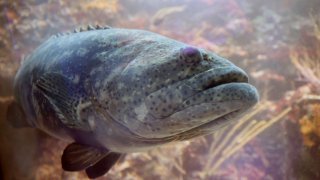
Florida lifted its three-decade ban on catching and killing goliath groupers Thursday with state officials enacting a highly restricted catch of 200 annually, saying the coastal fish's numbers have rebounded sufficiently since they were driven to near-extinction.
The Florida Fish and Wildlife Conservation Commission voted to allow the catching of younger goliaths of between 2- and 3-feet in length, which would put them at about 30 pounds (13 kilograms). Adult goliaths typically weigh 400 pounds (180 kilograms) but can exceed 800 pounds (360 kilograms). While the species’ population is unknown, state officials believe it has grown enough to allow the limited catch, the first since the early 1990s.
Who can catch goliath groupers and what are the fees?
Anglers who want to catch a goliath would have to enter a lottery, paying $10. Florida residents drawn to receive a permit for one fish will pay $150, while nonresidents will pay $500. The harvest season will run from March 1 through May 31 and spearfishing of goliaths will be prohibited.
Get South Florida local news, weather forecasts and entertainment stories to your inbox. Sign up for NBC South Florida newsletters.
The goliath almost died off in the 1980s from overfishing and pollution and is not allowed to be caught in any other state or federal waters. They are a favorite of underwater photographers because of their docile manner and mammoth size.
The commissioners agreed with harvest supporters, who told them there are now enough goliaths to make a limited catch feasible.
Local
“We believe that this proposal has been thoughtfully constructed to allow for continued rebuilding of this iconic stock while providing sustainable access to the fishery,” said Gary Jennings, of the American Sportfishing Association.
But biologist Christopher Malinowski, who studies groupers, told the commission that not enough research has been done to allow a harvest. He said more study is needed on the species' genetic diversity, its migration and on the effect of water quality on its health.
“This harvest will not get us any closer to understanding the fish's recovery” and could hinder it, he said.
How the goliath grouper almost became extinct
The goliath once ranged over a wide swath of ocean territory, from the Carolinas to the Caribbean and the Atlantic Ocean off Brazil, but its numbers dropped sharply starting in the 1960s. By 1990, humans had driven it almost extinct.
First, it was overfished — the goliath is easy to catch, living in known locations and spawning at specific spots. Florida’s new regulation prohibits catching the fish at spawning sites and during spawning season.
Also, the goliath’s first six years are spent hiding among mangroves, trees that grow in shallow coastal waters. Many mangroves have been lost to development and pollution, limiting where juveniles can grow.
Today, the goliath is found mainly off South Florida. Adults live in reefs and shipwrecks, digging holes that provide hiding spaces for other fish.



